
(Clockwise from top left) Helleborus, Larkspur, Ipheion uniflorum, Eryisistable wallflower | Allan Armitage
At this time of year when winter still has us in her clutches, most of the landscape/gardening world is hibernating. People are not asleep; they are restlessly awaiting the day when the garden starts to come alive. They also are asking themselves what they can put in the garden beds for early season color.
They may be a little tired of the pansies and violas, perhaps somewhat weary of kale, and are still waiting for snapdragons and dianthus to catch their second breath. That is a good thing. We want everyone to anticipate not only what might reappear but also what is available to plant for color in late February, March, and April.
Here are a few early-season flowerers. It would be nice if some of these “I can’t wait” plants were available now.
Hellebores
I have written about this group of plants many times, but it is such a no-brainer. With the major advances in breeding, there is no excuse not to be growing these hybrids. It is a multi-dimensional plant.
I see hellebores in flower at Trader Joe’s before Christmas being sold as an indoor plant — and why not? They will be handsome in the house, and once they flower out can be put in the garden. But even if not ready in December, these can come off the greenhouse bench in January and February and become the leader in retail to bring people in a little earlier. Obviously, if 6 feet of snow is on the ground, it may be tough to plant them. But in many areas of the country, budded hellebores can easily be planted in March (or earlier). Partner them with budded or flowering snaps — I can see a “Snap Up a Hellebore” program somewhere this winter.
Larkspur
The larkspur market has become much healthier, in part because of its expanded interest as a cut flower, but also because it is so early to bloom. I have yet to see flats of larkspur being offered in any retail outlet, forcing the landscaper/gardener to fight with seed.
There is little doubt the thin, upright stems of larkspur present a challenge to having an eye-catching product on the bench. It may simply not be worth the effort. However, as with early hellebores, it could be a “special offering” for early spring sales. This plant is beautiful, colors the early spring landscape, then goes away after flowering to allow something new for summer color. To ignore it is to ignore an opportunity. On the other hand, we can always sell more kale.
Wallflower
Now here is a plant whose uptick in breeding is definitely worth a second look. Wallflowers have been sold for decades, and in areas like the Northwest — and perhaps the Northeast — they are early, beautiful, and can sell themselves. However, as much as the breeding has evolved, they have never really caught on in this country. Their attributes of earliness, beauty, and sweet fragrance are offset by their lack of heat, humidity, and moisture tolerance. The result is an embarrassment of dead or put-me-out-of-my-misery plants in late spring or summer throughout the country.
However, every year the breeding improves, and I have seen plants flower longer, foliage that hangs in throughout the season, and more perennial (Zones 7 [maybe 6] to 10). The breeding of the Erysistable series from Syngenta has very much caught my eye.
Ipheion
Here is where readers will look at me askance, mumbling, even shouting, that Dr. A has truly lost it. Perhaps I am grasping a wee bit here, but last month I wrote about selling more bulbs into the early market by forcing containers to be garden-ready in the early spring.
Well, the spring starflower (Ipheion) is easy to program in pots, is available in different colors, flowers early, is rodent and deer-proof, has a lovely fragrance, and comes back in Zones 6 to 10. That is a robust list of good attributes. Like the hellebore, if forced, it could also be a houseplant to be placed outdoors after flowering is complete. I get it; nobody has heard of it. So what, with a name like spring starflower, introduce it to your buyers; it may be easier than you think.

